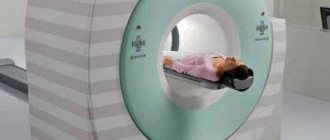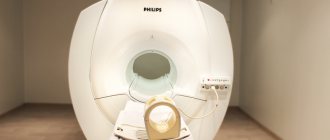Article:
A child with autism spectrum disorder forces parents to seek and test all possible treatments.
Priority is often given to new techniques, the effects of which have not always been sufficiently studied. One of the latest developments in therapeutic effects on the brain is micropolarization. There are many reviews from parents and specialists about the effect of treatment on the brain function of a child with autism. Often they are directly opposite in nature. So what is brain micropolarization and how does it treat autism?
Micropolarization - what is it?
Micropolarization of the brain is the effect of a low-frequency electric current of low strength on it. The treatment was developed to correct organic brain lesions in previously intact patients. Electrical exposure is carried out during the rehabilitation period after injuries or stroke.
In children, micropolarization of the brain for autism and delayed speech development has recently begun to be used. As an official technique, it is carried out at the Bekhterev Institute.
There are:
- Transcranial treatment. Here, electric shock is applied directly to the child’s brain.
- Transvertebral impact. Electric current affects the brain indirectly, stimulating the spinal cord.
How is micropolarization done? Electrodes are connected to the patient (on the head or back area) for 10 to 50 minutes (the time is increased gradually with each session). The baby can play or relax. Exposure to electric current does not cause any discomfort, since its strength is comparable to natural impulses.
The course of treatment is 10-12 sessions, the time of which is increased progressively. It is believed that the treatment has a delayed effect, so it can be assessed after 2-3 months. Repeated micropolarization of the brain in autism is allowed to be carried out no earlier than after 6 months. This time is necessary for an objective assessment of the effect of therapy on the child’s development.
Micropolarization of the brain and spinal cord
No entries found.
“Medicine is made up of science and art, and over them stretches a wonderful veil of heroism.”
Hugo Glaser.
ANOTHER INNOVATION – MICROPOLARIZATION
The development of science in the field of medicine today occurs at an extremely fast pace, but it keeps pace with the times and is actively introducing advanced technologies into practice. One of them is brain micropolarization. Currently, Avicenna remains the only medical center for children that provides the micropolarization method in the compulsory medical insurance system. Neurologist Irina Aleksandrovna Voloshkina and neurophysiologist Larisa Valerievna Lysenko talk about what this technology is.
Irina Aleksandrovna, what is the meaning of micropolarization?
Micropolarization is a targeted effect on brain cells through a small direct current. Microcurrents stimulate the affected structures of the central nervous system, reaching even deep peripheral areas that are inaccessible to other treatment methods.
What types of micropolarization are there?
There are two types of micropolarization: transcranial and transvertebral. The difference lies in the location of the electrodes, which in the first case are applied to the area of the head or a specific lobe of the brain for local impact, and in the second, stimulation of spinal cord neurons is used.
How is the micropolarization procedure performed?
When micropolarizing the brain, a special helmet-cap with electrodes located on it is placed on the child’s head. The method involves local impact on certain areas of the brain, due to which electrodes can be attached where pulse stimulation is needed. During the procedure itself, the child can actively go about his business (communicate, read a book, play, watch cartoons). The session lasts about half an hour. To achieve a good therapy effect, several procedures are necessary.
Dmitry Anatolyevich, how do you understand how many procedures a child needs?
Their number, duration of sessions, and places where electrodes are applied are determined by a neurologist after conducting a full comprehensive examination. The list of necessary studies, which, if indicated, will be prescribed by a medical doctor before the procedure, may include electroencephalography, electromyography, evoked brainstem potentials, Dopplerography of the vessels of the head and neck.
In what cases can a neurologist recommend taking a course of brain micropolarization?
Among the main children's problems that this technique can cope with are delayed mental and psycho-speech development, motor and partially sensory alalia, speech disorders, hyperactivity syndrome, attention deficit disorder, and increased impulsivity. Patients also include children with traumatic brain injuries, vascular diseases (vegetative dystonia syndrome), consequences of neuroinfections of the brain, visual and auditory dysfunctions (nystagmus, strabismus, sensorineural hearing loss) and many types of neurological disorders: fears, aggressiveness, tics, psychogenic enuresis.
Is electric current dangerous for the baby?
The current strength is so low that it is not capable of harming a growing organism. However, the pulse power is sufficient to stimulate sensitive brain cells. In general, the method is well tolerated by children. The procedure is painless, has no side effects and no complications. The effect on the central nervous system is carried out without drugs.
What can parents expect when bringing their child to micropolarization sessions?
As a result of the treatment, the cognitive functions of the brain improve (attention, memory, thinking), motor development accelerates, speech understanding and pronunciation clarity are established, the active vocabulary expands, children begin to speak and switch to phrases and sentences. Boys and girls develop an interest in the world around them, a desire to communicate and learn, a decrease in aggressiveness, and disappearance of fears. In capricious children, hysterical manifestations are eliminated. The course also helps normalize muscle tone and sleep, and eliminate headaches.
How long does the effect last?
The effectiveness is maintained over a fairly long period of time, the maximum result is visible 30-60 days after the full course. Micropolarization is often carried out in combination with other types of rehabilitation treatment: massage, exercise therapy, manual therapy, classes with a speech therapist. At the same time, the effectiveness of these techniques increases significantly and the healing process is accelerated.
Attention! If you have a referral to a neurologist from a local clinic, treatment is provided free of charge under your compulsory health insurance policy. At the request of parents, their child can take a brain micropolarization course for a fee; a referral is not required.
Dear parents!
To receive a course of transcranial micropolarization, a preliminary study is required - an EEG with functional tests and transcranial NSG (no more than 3 months old), based on the results of which the neurologist determines the indications/contraindications for prescribing this type of rehabilitation treatment and the points for applying the electrodes. Thus, to receive a transcranial micropolarization course you must:
- on a paid basis - sequentially: do an EEG, transcranial NSG (or bring the result of a study no more than 3 months old), consult a neurologist, sign up for micropolarization.
Micropolarization – benefit or harm?
It is considered proven that micropolarization of the brain during speech delay has a positive effect, stimulating and strengthening synaptic connections. In the case of autism, the causes of which are themselves poorly understood, micropolarization is recommended as a method to “try.”
Note! There is no official evidence of the effectiveness of micropolarization for the treatment of autism. The promotion of the method is based on the hypothetical benefits and positive experience in the rehabilitation of adult patients with speech and motor disorders.
It is officially believed that exposure to a weak current for short sessions cannot cause any harm. However, there are conditions in which such treatment cannot be carried out.
Contraindications
Micropolarization is contraindicated in case of individual sensitivity to the action of electrical impulses.
Electrical treatment is not carried out:
- for dermatological diseases localized at the site where the electrodes are attached;
- with increased excitability of patients;
- children with autism who are prone to hysterical reactions;
- patients who have vascular pathologies;
- patients with neoplasms;
- simultaneously with taking psychotropic medications;
- simultaneously with a course of other physiotherapy procedures.
If you have doubts about the benefits of the treatment, you should refuse the procedures. Autism as a disease is poorly understood. Micropolarization in autism remains just as little studied.
Indications for micropolarization
Micropolarization
– method of choice in the treatment of organic damage to the central nervous system, both in the acute period and in the stage of recovery or residual effects:
- cerebral palsy (spastic, hyperkinetic, cerebellar forms);
- traumatic brain injury (concussion or bruise, cerebral contusion);
- stroke in the acute period (starting 1-2 days after the “brain catastrophe”),
- consequences of ischemic or hemorrhagic stroke (“vegetative state”, hemiparesis, spasticity, ataxia, aphasia, alalia);
- consequences of neuroinfectious diseases of the brain;
- delayed neuropsychic development of the child and learning problems;
- speech development disorders in children;
- anxiety, neurotic and psychosomatic disorders;
- epilepsy and paroxysmal (convulsive) syndromes;
- dementia;
- impairment of visual and auditory functions;
- migraine.
Who is the treatment indicated for?
Experts recommend micropolarization for speech delay, autism, and epilepsy. The positive effect is manifested in the patient’s daily life. Increased interest in what is happening around, the emergence of new words, the desire to interact with other people, an emotional response to touch or treatment.
Positive reviews about the influence of micropolarization on speech development, social adaptation and behavior of children with developmental disorders allow us to note:
- improving the child’s adaptive capabilities;
- increased emotional background, improved mood;
- stabilization of night sleep, facilitating the process of falling asleep;
- improvement of short and long-term memory;
- increasing concentration and learning ability.
Among the improvements in the physical condition of the body, an increase in visual acuity and the disappearance of problems with bedwetting have been officially recorded in some children.
Contraindications
In a number of clinical situations, transcranial micropolarization is unacceptable or inappropriate due to ineffectiveness.
Thus, contraindications to TCMP are as follows:
- acute inflammatory (infectious or other nature) diseases or exacerbations of chronic diseases that occur with an increase in the patient’s body temperature;
- malignant brain tumors;
- foreign bodies in the skull;
- severe cardiovascular pathology;
- impaired integrity of the scalp;
- pigment spots, rash, tumor-like formations in the area where the electrodes are supposed to be applied;
- systemic connective tissue diseases;
- individual hypersensitivity to the effects of electric current.
The effectiveness of therapy for these diseases is about 75%, that is, three out of four patients experience a positive effect.
In cases of severe psychiatric and genetic diseases, in particular with severe mental retardation, Down syndrome or autism, TCMP is ineffective and therefore not always advisable. However, these pathologies are not contraindications, and some experts sometimes recommend them to their patients, since even the smallest, but still positive, result is often important for them.
Reviews
Reviews from parents whose children have undergone electric shock treatment are contradictory. Some note that the effect is positive. Some make videos about the dangers of micropolarization for autistic children, noting regression in the development of communication and self-care skills.
Reviews from specialists who work directly with autistic people are mostly positive or neutral. Doctors note that the negative effect after treatment is short-term. The delayed effect is always positive.
Since the micropolarization method in the treatment of children with autism has been little studied, each parent has to make their own decision.
Autistic mother: “There are a lot of charlatans hanging around our children with “one hundred percent” effective methods. Just have time to pay, but no one guarantees the effect. How do you know if micropolarization really helps? Or is this just another commercial project?
How is the treatment carried out?
Before manipulation, electroencephalography is indicated to detect foci of damage. Exposure to currents of physiological intensity usually includes 10 sessions lasting about 30-40 minutes. A helmet equipped with electrodes is placed on the patient's head. If the body is exposed, use a similar belt.
During the session, you can read, play games, and do exercises with a speech therapist. Micropolarization
does not cause pain or discomfort in children.










